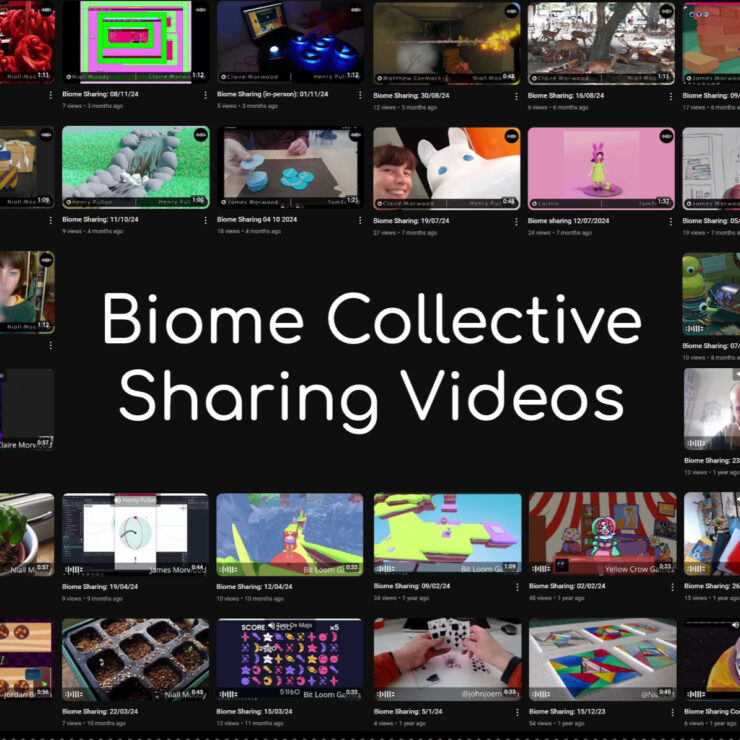How Many Stars, How Many Worlds, How Many Ways Of Being Alive?

As you enter the Cooper Gallery a TV monitor lies on a silk bedsheet, displaying a human figure lying on the same bright red silken sheets staring at the ceiling. Her breathing is the only indication that you’re watching a piece of video art, as her exposed breasts rise and fall. In knee high scarlet boots she looks like the victim of a sex crime – especially as her pose suggests a chalk body drawn on the ground during a murder investigation – while also referencing the iconic rose petal scene from American Beauty.
Quietly, a disembodied feminine voice asks: “What is she saying to you, what is she whispering softly into your ear? Sweet nothings? Your fly’s undone. Did you say you’re hungry babe. Let her touch you, comfort you, please you. She loves you you know, it’s just that she’s trapped in your picture frame.”
Behind this disconcerting scene are three wall mounted films featuring the same other-worldly person. While less immediately compelling, with headphones on a narrative emerges as you move between the three films. “Something alarming happened to me today. I was in a waiting room looking through a magazine when I came across an image of a woman who looked just like me,” says the same disembodied voice as the person on screen occasionally mouths the words in time to the narrative, emphasising them.
“It was like looking into a mirror and finding that there was something missing in the reflection.”
The story unfolds with increasing violence, as the narrator pokes holes through the eyes of the doppelgänger and brings the photograph up to her own face to wear like a mask. The language used in telling the story is rich and occasionally obscene, constantly drawing your attention to the fact that you’re watching someone who’s watching you watch them, a loop of feminine passivity where the cultural, masculine gaze is constantly subverted and re-affirmed. A process of taking on and identifying with images in the media, both consciously and unconsciously. This is the power of Victoria Sin’s ‘Narrative Reflections on Looking’, their contribution to the group show Ambiguous Becoming: Artists’ Moving Image from Canada, which is on until Saturday 22 February.
You leave and cross the street, walk down the road to Dundee Contemporary Arts and find yourself confronted by the same face and the same soft, feminine voice. This is Victoria Sin’s ‘BCE’, a collaboration with Qatari-American artist Sophia Al Maria, in the Seized By The Left Hand group show, which is on until Sunday 22 March.
In this video the non-binary Sin stands against a background of stars, dressed in white. Their half-Chinese heritage completely obscured by silver make-up – exaggerated red lips, one eye nude and one eye highly stylised, fake breasts exposed under a beautiful white dress, feet clad in impossible clear high-heeled boots.
Sin rose to prominence on the female drag queen scene in London. In an interview with Shades of Noir they explain; “Drag is a way for me to queer the performance of femininity, to be able to embody it and think through it without performing it to serve but rather to challenge the patriarchal gaze.”
The film is… discordant. Sin’s voice is distorted, poetic, and at times it seems that the words are less important than the overall atmosphere of the piece. Repeated viewings do reward the patient, as meaning slowly reveals itself. It helps to note that the entire Seized By The Left Hand group show is inspired by the novel The Left Hand of Darkness by the late Ursula K. Le Guin. The novel tells the story of a male diplomat sent to an alien planet where the human beings have no fixed sex or gender, instead being largely neuter for the majority of their time. Told almost entirely from the diplomat’s perspective it asks the reader to imagine a genderless society and forces us to reexamine our own unconscious assumptions about what it means to be a human being outside of the gender binary.
But back to the film. Sin’s soft voice speaks to us, saying, “We discover and we do not discover our identity, our gender, our race, our place in the world… we just needed the space, we needed the stars because all we could do was look at each other, pick our bodies apart and pick our beliefs apart.”
They continue, “As if one person could only be one thing for the rest of their many lives, as if god himself had not given us the ability to stand on two legs and look up.
“How many starts, how many worlds, how many ways of being alive?”
How many indeed. If Victoria Sin’s work tells us anything, it’s that video art has an extraordinary power to question both the act of looking itself and the performative potential of femininity going into a new decade.
By Ana Hine
Image: Victoria Sin, ‘Preface/Looking Without Touching’ (2016), single channel HD video, installation view Cooper Gallery 2020, photo by Sally Jubb


